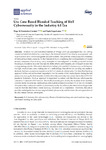Mostrar o rexistro simple do ítem
Use Case Based Blended Teaching of IIoT Cybersecurity in the Industry 4.0 Era
| dc.contributor.author | Fernández-Caramés, Tiago M. | |
| dc.contributor.author | Fraga-Lamas, Paula | |
| dc.date.accessioned | 2020-09-17T15:01:11Z | |
| dc.date.available | 2020-09-17T15:01:11Z | |
| dc.date.issued | 2020-08-13 | |
| dc.identifier.citation | Fernández-Caramés, T.; Fraga-Lamas, P. Use Case Based Blended Teaching of IIoT Cybersecurity in the Industry 4.0 Era. Appl. Sci. 2020, 10, 5607. https://doi.org/10.3390/app10165607 | es_ES |
| dc.identifier.issn | 2076-3417 | |
| dc.identifier.uri | http://hdl.handle.net/2183/26209 | |
| dc.description.abstract | [Abstract] Industry 4.0 and Industrial Internet of Things (IIoT) are paradigms that are driving current industrial revolution by connecting to the Internet industrial machinery, management tools or products so as to control and gather data about them. The problem is that many IIoT/Industry 4.0 devices have been connected to the Internet without considering the implementation of proper security measures, thus existing many examples of misconfigured or weakly protected devices. Securing such systems requires very specific skills, which, unfortunately, are not taught extensively in engineering schools. This article details how Industry 4.0 and IIoT cybersecurity can be learned through practical use cases, making use of a methodology that allows for carrying out audits to students that have no previous experience in IIoT or industrial cybersecurity. The described teaching approach is blended and has been imparted at the University of A Coruña (Spain) during the last years, even during the first semester of 2020, when the university was closed due to the COVID-19 pandemic lockdown. Such an approach is supported by online tools like Shodan, which ease the detection of vulnerable IIoT devices. The feedback results provided by the students show that they consider useful the proposed methodology, which allowed them to find that 13% of the IIoT/Industry 4.0 systems they analyzed could be accessed really easily. In addition, the obtained teaching results indicate that the established course learning outcomes are accomplished. Therefore, this article provides useful guidelines for teaching industrial cybersecurity and thus train the next generation of security researchers and developers. | es_ES |
| dc.description.sponsorship | This work has been funded by the Xunta de Galicia (ED431G 2019/01), the Agencia Estatal de Investigación of Spain (TEC2016-75067-C4-1-R, RED2018-102668-T, PID2019-104958RB-C42) and ERDF funds of the EU (AEI/FEDER, UE) | es_ES |
| dc.description.sponsorship | Xunta de Galicia; ED431G 2019/01 | es_ES |
| dc.language.iso | eng | es_ES |
| dc.publisher | MDPI AG | es_ES |
| dc.relation.uri | https://doi.org/10.3390/app10165607 | es_ES |
| dc.rights | Atribución 4.0 Internacional | es_ES |
| dc.rights.uri | http://creativecommons.org/licenses/by/4.0/ | * |
| dc.subject | IIoT | es_ES |
| dc.subject | Industry 4.0 | es_ES |
| dc.subject | Cybersecurity | es_ES |
| dc.subject | Shodan | es_ES |
| dc.subject | Blended teaching | es_ES |
| dc.subject | Use-case based teaching | es_ES |
| dc.subject | Use case based learning | es_ES |
| dc.subject | Security audit | es_ES |
| dc.title | Use Case Based Blended Teaching of IIoT Cybersecurity in the Industry 4.0 Era | es_ES |
| dc.type | info:eu-repo/semantics/article | es_ES |
| dc.rights.access | info:eu-repo/semantics/openAccess | es_ES |
| UDC.journalTitle | Applied Sciences | es_ES |
| UDC.volume | 10 | es_ES |
| UDC.issue | 16 | es_ES |
| UDC.startPage | 5607 | es_ES |
| dc.identifier.doi | 10.3390/app10165607 |
Ficheiros no ítem
Este ítem aparece na(s) seguinte(s) colección(s)
-
GI-GTEC - Artigos [190]






